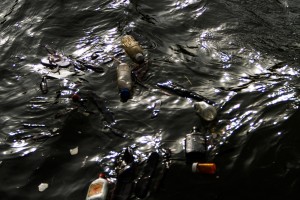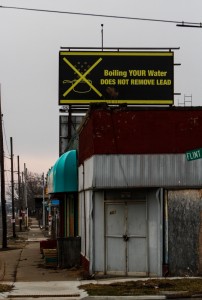Flint, Michigan is a city with a tumultuous history. Once proudly named “Vehicle City,” Flint – home of General Motors – stood as the second largest auto-manufacturing town in America. The series of financial crises that rocked the nation during the twentieth century eventually led GM to close its plants, devastating Flint. The road to recovery has been slow and painful. And it looks like it will be slower still. The world is looking to Flint again, this time in the wake of another disaster. The Flint Water Crisis is the product of systemic sociopolitical and racial disparities that have ailed the city since its founding. Still unfolding, the incident exposes a combination of unjust governing policies, gross negligence, and a refusal to acknowledge the plight of a historically vulnerable population. In most cases of environmental pollution, harm is not spread equally; Flint is no different. The social, economic, and political marginalization of impoverished, minority, redlined communities in Flint set them up for decades of disinvestment and neglect. These neighborhoods have felt the disparate impact of the crisis, given that their dilapidation made them more prone to contamination. To understand the roots of the current crisis, it is necessary to dig down into the history books, back to Flint’s “glory days.”
First, an overview of the Water Crisis: In April 2014, two Emergency Managers did away with a long-standing water contract with Detroit, in anticipation of a pipeline from Lake Huron that would bring water directly to Flint. Their switch to Flint River water would save the city $12 million annually until pipeline completion.[1] Michigan’s Constitution provides that, in the case of a financial emergency, the governor can appoint Emergency Managers (EMs) to assume control of the city in order to remedy the crisis.[2] Since 2011, unelected EMs have held office in Flint. Beholden to neither local nor municipal officials, they decided that it was in Flint’s best interest to give up a safe, reliable source of water for one in which cars, trash, and dead bodies have been found. The Michigan Department of Environmental Quality (DEQ) approved the switch, foreseeing no change in water quality. The heavily polluted and poorly treated Flint River water began to corrode the city’s lead pipes. Just a month after making the switch, residents began making complaints of the new water’s strange appearance and odor. The DEQ reassured Flint that “turbidity, residual chlorine and bacteria levels meet all standards set by the state.”[3] In the months following the switch, residents started coming down with rashes, headaches, hair loss. Officials paved over concerns. They added more chlorine to the water, resulting in a violation under the Safe Drinking Water Act for trihalomethanes (TTHM) – a disinfectant byproduct.[4] In August of 2014 city officials found E. coli in the water; they mandated nothing more than a boil order.[5] GM stopped using the water when they discovered it rusted car parts. Michigan Gov. Rick Snyder, the EMs, the DEQ, and various other government officials refused to switch Flint’s water source back to Detroit and subverted residents’ claims of environmental pollution. It would not be until January 2016 that Snyder would declare, and President Obama would approve, a state of emergency for the city.

Flint River Water // Photo by Sarah Rice for Getty Images
As stated earlier, Flint’s vulnerability to the devastating effects of the water crisis stems from a history of marginalization. Flint River water leached lead more from certain pipes, because those pipes sat in dilapidated houses in poor, minority communities that had been kept that way through a history of racist housing policies. Marginalization in Flint was an import of big business. Flint fought hard at the turn of the twentieth century to raise the capital needed to keep the newly relocated Buick Motor Company in town. Their gamble paid off. Two years later, Buick’s Chief Tyler Durant founded GM and quickly established Flint as a hub of auto manufacturing. Through 1930, Flint had a population that was 80% white, and only 3.6% black.[6] Even then, Flint’s small black community was kept segregated to a select few areas, one of them being the polluted, run down neighborhood of St. John St. In 1919 GM founded the Modern Housing Corporation to provide housing for its workers in just over a decade built almost three thousand houses in Flint. The housing policies that GM set in place, Andrew Highsmith outlines, allowed Jim Crow to take root in Flint. GM had covenants, one of which dictated that homes, “‘could not be leased to or occupied by any person or persons not wholly of the white or Caucasian race.’”[7] Racist housing policies alone made Flint the “third most segregated city in the nation.”[8] Jim Crow delineated spaces reserved for blacks’ not only in neighborhoods, but also in the workforce. As far as GM was concerned, the assembly line was the place of the whites. Black workers were forced to take positions as “janitors or foundry workers.[9] Segregated schools and discriminatory store practices only made life more inhospitable for Flint’s black population. The Great Depression’s nearly 75 percent cut to auto manufacturing sent Flint’s unemployment rates skyrocketing to almost 50 percent.[10] The banks all but ceased lending, resulting in rampant housing shortages.
The federal government responded by creating the Home Owners’ Loan Corporation (HOLC) to buy and refinance mortgage loans for those defaulting on payments. However, the system of valuation reproduced racist policies, as only white homes received the highest value grades.[10] This process became known as redlining, and established which communities held worth, and which were too risky to invest in.[11] The HOLC was followed by the 1934 establishment of the Federal Housing Administration (FHA), which insured bank loans and mortgages in order to assuage banks’ doubts about lending to prospective homeowners. The FHA, too, carried out assessments of which home mortgages should be insured that relied on racial demographics as a metric for judging risk of investment.[12] FHA policies all but halted the construction of homes for blacks. The post-World War II boom and labor shortage in Flint, Highsmith says, “trigger[ed] a mass migration of black workers to Flint.”[13] The city’s black population doubled in seven years. However, this far from solved the housing crisis.The FHA-induced real-estate revival resulted in mass evictions of black renters as white landlords looked to cash in on mortgages. And, in this period of tremendous growth, developers built only 25 new homes for blacks – all in the redlined St. John St. neighborhood.[14] The influx of African Americans to Flint sparked a parallel exodus of white residents, many of whom left the city, leaving Flint’s marginalized communities to suffer the burden.
Economic growth in the following decades did not translate to urban renewal for neighborhoods like St. John St. They remained the most polluted in the city – lacking any sort of investment. In 1971, GM, Flint’s economic foundation, followed the trend in disinvestment beginning a series of sweeping cuts to its workforce. The “strong trade unions, high wages, obsolete infrastructure, and increasingly anti-corporate political climate” that developed in the years preceding, like white flight, turned GM away from the city.[15] The company began to invest elsewhere. OPEC’s 1973 oil embargo on the U.S. and the 1979 drop in oil production hit Flint hard. In 1975, unemployment stayed in the range of 15 and 20 percent, 50 percent for African Americans.[16] Again, Flint residents took flight: within eight years the population fell 20 percent. Property abandonment and neglect for remaining communities – many, poor minority neighborhoods – were rampant. In response to huge financial losses, GM worked to increase efficiency by “spatially [integrating] manufacturing and assembly” by centralizing production in a $475 million facility called Buick City.[17] In November 1999, following a decade of plant closures, GM shut down the facility. Flint was left to suffer a 30.8 percent poverty rate – 36.4 percent for blacks.[18]
In the wake of GM’s Buick City closure and parallel closures in Detroit, Michigan has struggled to regain economic footing. Since 1990 local governments have had the power pursuant to Public Act 72 to appoint Emergency Managers in order to ensure that citizens receive “basic services” during a financial emergency. The state first exercised that authority in 2009.[19] EMs are instituted in order to mitigate fiscal effects on communities, but they assume control of aspects of city regulation ranging from education to public health. Emergency Managers are not locally elected officials. Their appointment completely undermines citizens’ ability to select their own leaders, threatening principles fundamental to American democracy. Many have called the system racist. As a Root article explains, “Emergency financial managers have been primarily assigned to majority-African-American cities across Michigan. In the past decade, over half of African Americans in Michigan—compared with only 2 percent of whites—have lived under emergency management.”[20] Emergency Managers, residents argue, represent a conservative, white leadership. Labor unions have found their agreements with city officials essentially null and void.[21] The fact that EMs are fiscal specialists but are delegated with public health has meant that many health concerns go under-noticed and under-treated – a criticism with particular salience in the wake of the Water Crisis.[22] The six EMs who have controlled Flint since 2011 have undertaken their fiscal responsibilities by, in some cases, cutting pay or jobs for city employees, and raising water costs or taking from the water budget.[23] Their appointment left Flint’s government without authority to “independently check water quality after concerns were raised.”[24] Emergency Law set Flint up to have poor decisions made, without accountability, on behalf of residents and left the city without the political resources to respond to an incident. In short, emergency management set Flint up for disaster.
The disaster, once it hit, did not have equitable effects. Flint’s history of racist housing policies established under the HOLC and FHA and upheld by social, economic, and political forces in the decades following ensured that the impact be felt disproportionately. It helps to note that the current water crisis is not Flint’s first incident of lead pollution. The 1992 construction of the $80 million Genesee Power Station and incinerator in the predominantly black North End (a region including St. John St.) showed how labeling a community as “undesirable” makes it the target of undesirable activities (like waste disposal). The North End was widely recognized to be the most polluted area in Flint. This of course was because developers and city officials had, over the decades, ensured that it be such. As a result, they had few qualms about poisoning the North End’s air, burning wood coated in lead-based paint.[25] Then, as now, the DEQ neglected residents’ concerns about the dangers of the project, suggesting that it was making the fiscally savvy decision for the good of Flint.[26] Residents’ joint suit with the NAACP and activist group United for Action was ultimately filed in vain. Similar dynamics were at play in regards to the water crisis. It was in September of 2016, more than two-and-a-half years after Flint changed its water source, that the first tests were conducted – not by the government – on residents’ blood lead levels. Pediatrician Mona Hanna-Atisha’s findings were startling. The number of children with lead poisoning rose from 2.4% to 4.9% after the switch to the Flint River.[27] More significantly, numbers in the “socioeconomically disadvantaged,” predominantly black Fifth Ward rose from 4.9% to 15.7% revealing marginalization to be a key factor in crisis evaluation.[28] A Wall Street Journal article ascribes the data gap to limited access to “bottled water and filters” and “poor nutrition” (and thus greater vulnerability to lead poisoning) for the “40% of the population liv[ing] below the poverty line.”[29] Virginia Tech professor Marc Edwards who has been leading the charge to test Flint’s water additionally points out that, as previously mentioned, “water tends to sit in pipes longer in neighborhoods with vacant houses,” – that is, disadvantaged minority communities – and thus has a greater corrosive effect.[30]
State officials initially denied Hanna-Atisha’s findings, along with a host of other independently conducted studies. What becomes clear is that the Water Crisis is larger than water; it is the story of a city that allowed certain communities to corrode and was deaf to their plight. Only now, with the nation’s eyes on Flint, have officials have let up in their suppression campaigns and begun to open a window on the conditions that governments, developers, and residents have chosen to ignore and perpetuate.
[1] Mitch Smith, “A Water Dilemma in Michigan: Butty or Costly?” New York Times, March 24, 2015, accessed March 16, 2016, http://www.nytimes.com/2015/03/25/us/a-water-dilemma-in-michigan-cheaper-or-clearer.html?_r=1.
[2] “Emergency Manager Law,” State of Michigan, accessed March 16, 2016, https://www.michigan.gov/documents/snyder/EMF_Fact_Sheet2_347889_7.pdf.
[3] Hannah Rappleye, Lisa Riordan Seville and Tacy Connor, “Decisions, Broken Promises: A Timeline of the Flint Water Crisis,” NBC News, accessed March 16, 2016, http://www.nbcnews.com/news/us-news/bad-decisions-broken-promises-timeline-flint-water-crisis-n499641.
[4] Smith, “A Water Dilemma in Michigan.”
[5] Smith, “A Water Dilemma in Michigan.”
[6]Andrew Highsmith, Demolition means progress: Flint, Michigan, and the fate of the American metropolis (Chicago: University of Chicago Press, 2015): 27.
[7] Highsmith, Demolition means progress, 32.
[8] Highsmith, Demolition means progress, 34.
[9] Highsmith, Demolition means progress, 34.
[10] Highsmith, Demolition means progress, 37.
[11] Highsmith, Demolition means progress, 38.
[12] Highsmith, Demolition means progress, 39.
[13] Highsmith, Demolition means progress, 50.
[14] Highsmith, Demolition means progress, 50.
[15] Highsmith, Demolition means progress, 50.
[16] Highsmith, Demolition means progress, 243.
[17] Highsmith, Demolition means progress, 246.
[18] Highsmith, Demolition means progress, 255.
[19] Highsmith, Demolition means progress, 254.
[20] Highsmith, Demolition means progress, 254.
[21] “Emergency Manager Law”.
[22] Louise Seamster and Jessica Welburn, “How a Racist System Has Poisoned the Water in Flint, Mich.,” The Root, January 9, 2016, accessed March 16, 2016, http://www.theroot.com/articles/politics/2016/01/how_a_racist_system_has_poisoned_the_water_in_flint_mich.html.
[23] Steven Yaccino, “Michigan Voters Repeal a Financial Law,” New York Times, November 7, 2012, accessed March 16, 2016, http://www.nytimes.com/2012/11/08/us/michigan-voters-kill-emergency-managers-for-city-finances.html.
[24] Julie Bosman and Monica Davey, “Anger in Michigan Over Appointing Emergency Managers,” New York Times, January 22, 2016, accessed March 16, 2016, http://www.nytimes.com/2016/01/23/us/anger-in-michigan-over-appointing-emergency-managers.html?_r=0
[25] Highsmith, Demolition means progress, 252.
[26] Highsmith, Demolition means progress, 27.
[27] Seamster and Welburn, “How a Racist System”
[28] Seamster and Welburn, “How a Racist System”
[29] Kris Maher, “U.S. News: Flint’s Poorest at Center of Crisis – Research Finds the Highest Lead Exposure among City’s Children in Least Affluent Wards,” Wall Street Journal, February 29 2016, ProQuest, accessed March 16 2016, http://search.proquest.com/nationalnewspremier/docview/1768524821/EF27AAEDA74245D4PQ/21?accountid=15054.
[30] Maher, “Flint’s Poorest at Center of Crisis.”
[31] Maher, “Flint’s Poorest at Center of Crisis.”
[32] Maher, “Flint’s Poorest at Center of Crisis.”



